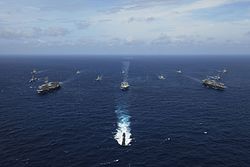| Bay of Bengal | |
|---|---|
 A map of the Bay of Bengal | |
| Location | South Asia and Southeast Asia |
| Coordinates | 15°N88°E / 15°N 88°E |
| Type | Bay |
| Primary inflows | Indian Ocean |
| Basin countries | Bangladesh India Indonesia Myanmar Sri Lanka |
| Max. length | 2,090 km (1,300 mi) |
| Max. width | 1,610 km (1,000 mi) |
| Surface area | 2,600,000 km2 (1,000,000 sq mi) |
| Average depth | 2,600 m (8,500 ft) |
| Max. depth | 4,694 m (15,400 ft) |
| References | World Atlas, [1] Asiatic Society of Bengal (India), Asiatic Society of Bangladesh [2] |
| Location | |
 | |
The Bay of Bengal is the northeastern part of the Indian Ocean. Geographically it is positioned between the Indian subcontinent and the Indochinese peninsula, located south of the Bengal region.
Contents
- Background
- Extent
- Etymology
- History
- Significance
- Economic importance
- Geostrategic importance
- Religious importance
- Key features
- Beaches
- Channels
- Islands
- Rivers
- Seaports
- Oceanography
- Geology
- Oceanographic chemistry
- Oceanographic climate
- Marine biology, flora and fauna
- Transboundary issues
- Ecological degradation
- Environmental degradation
- Tropical storms and cyclones
- See also
- References
- Further reading
- External links
Many South Asian and Southeast Asian countries are dependent on the Bay of Bengal. Geopolitically, the bay is bounded on the west and northwest by India, on the north by Bangladesh, and on the east by Myanmar and the Andaman and Nicobar Islands of India. Its southern limit is a line between Sangaman Kanda, Sri Lanka, and the northwesternmost point of Sumatra, Indonesia. [1] [2] Cox's Bazar, the longest sea beach in the world and Sundarbans, the largest mangrove forest and the natural habitat of the Bengal tiger, are located along the bay.
The Bay of Bengal occupies an area of 2,600,000 square kilometres (1,000,000 sq mi). A number of large rivers flow into the Bay of Bengal: the Ganges–Hooghly, the Padma, the Brahmaputra–Jamuna, the Barak–Surma–Meghna, the Irrawaddy, the Godavari, the Mahanadi, the Brahmani, the Baitarani, the Krishna, the Kaveri and the Penna River.












